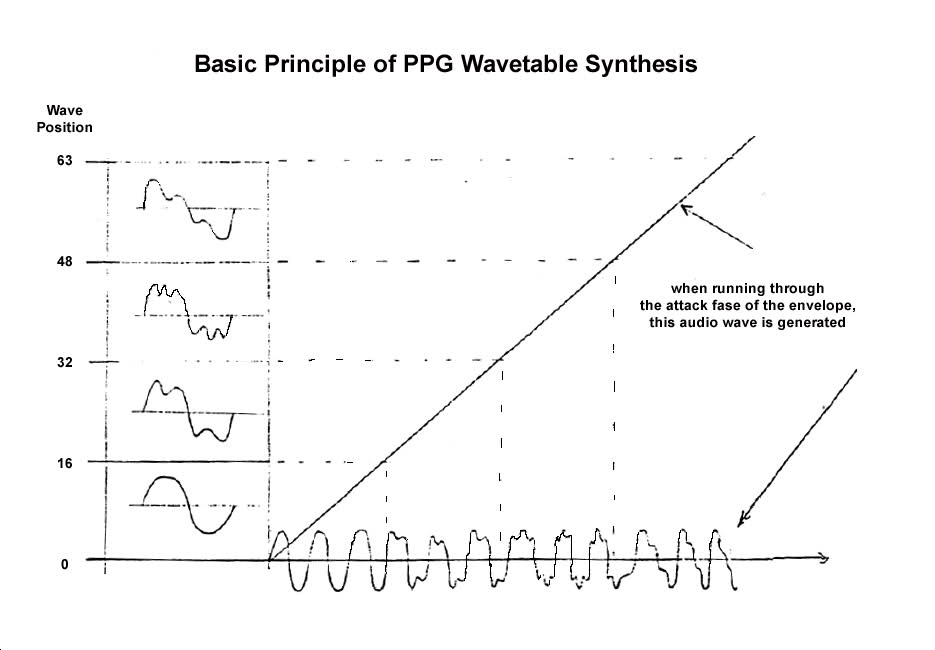The PPG Story
By now it was the year 1979, and we had strong competition from America, especially the "Oberheim 4 / 8 voice" models and the "Prophet 5" were very popular with professional musicians. Both were fully analog synths that contained a (more or less) complete Minimoog per voice. The Prophet 5 was far more compact than the Oberheim (the sale prices, too).
In any case, every musician now wanted to have a polyphonic synth. The big question for me was: "How can you simplify the thing?" And digital technology offered itself. Pretty soon, I had the idea that an oscillator had to change its waveform dynamically, and that you could produce all imaginable sounds with it.
Each wave should have 128 samples, and if you would hold 64 of those periods in memory, this could form a beautiful sound development, and the memory requirements were - even for the time being - realizable.
So far, so good, but from where should I get the waveforms? OK, the standard synth waves: sawtooth, pulse, and triangle, were defined easily, and some abstract waves, too, but I also wanted to realize wind and string sounds. Here, my university studies helped me, where I also learned about acoustics; so I looked up in a textbook what I could find. There were graphics of some spectra of trumpet, violin etc. and I could measure the strength of the harmonics with a ruler. There was a description of an experiment where you could measure the strengh of the single partials by producing standing waves in a tube (I found exactly this: the so called Rubens Tube )
As said, back then there were maybe some universities in the USA where you could do real sound analysis, but that wasn't known, and least of all, accessible to me.
Now I had some spectra and a little sine synthesis program that Wolfgang Kowalk had written, and could transform these spectra into waveforms. Then, I could load these into specific positions in the wavetable and play them with a digital oscillator.
Wow! That really was an experience! But I also wanted to simulate a complete filter sweep with the Wavetables. So I took a sawtooth spectrum, removed some harmonics at the upper end, then some more for the next wave and so on until only a sine wave was left.
If you played this, it didn't really sound like a Moog sweep, but everything had this jingle to it that made the PPG Wave so famous later on. Anyway, in this way I did most of the Wavetables that are still available in the Waldorf synths and in the "PPG Wave 2.V" VST PlugIn.
A graph from the first Wavecomputer users manual, explaining the wavetable principle:
Es war nun das Jahr 1979, und es gab starke Konkurrenz aus Amerika, speziell die "Oberheim 4 / 8 voice" Modelle und der "Prophet 5" waren sehr beliebt unter Profi Musikern. Beides waren voll analoge Synths, die pro Voice (mehr oder weniger) einen kompletten minimoog enthielten. Wobei der Prophet5 schon wesentlich kompakter aufgebaut war, als der Oberheim. (entsprechend waren auch die Verkaufspreise)
Auf jeden Fall wollte jeder Musiker jetzt einen polyphonen synth haben. Für mich stellte sich die Frage: "wie kann man das ganze einfacher machen ?". Und da bot sich die digital-Technik an. Ich hatte schon bald die Vorstellung, dass ein Oscillator dynamisch seine Wellenform ändern müsste, und man damit alle nur erdenklichen sounds erzeugen könnte. Jede Welle sollte 128 samples haben, und wenn man 64 solche Perioden in einem Speicher halten würde, könnte das einen schönen Klangablauf ergeben, und der Speicherbedarf war, auch für die damalige Zeit, realisierbar.
Soweit so gut, aber woher sollte ich diese Wellenformen bekommen? Ok, die standard synth wellen: sawtooth, pulse und triangle, waren schnell definiert, und einige abstrakte wellen ebenso, aber ich wollte auch Bläser und Streicher realisieren.
Da kam mir mein Studium zugute, in dem ich auch Akustik hatte, und ich schaute in einem Lehrbuch nach, was es da alles gab. Da waren ein paar Spektren von Trompete, Violine etc. und ich konnte die stärke der Obertöne von den abgebildeten Grafiken mit einem Lineal abmessen.
Es war da ein Versuch beschrieben, bei dem man die Stärken der einzelnen Obertöne messen kann, indem man "stehende Wellen" in einem Rohr erzeugt. (hab jetzt genau das gefunden: die sogenannte Rubens Tube)
Wie schon gesagt, es gab damals vielleicht ein paar Unis in den USA, wo man schon echte Analysen von Sounds machen konnte...aber mir war das natürlich nicht bekannt, und schon garnicht zugänglich.
Ich hatte also jetzt ein paar Spektren und ein kleines Sinus-Synthese Programm, was Wolfgang Kowalk geschrieben hatte, und konnte nun diese Spektren in Wellenformen umsetzen. Diese konnte ich dann in bestimmte Positionen des Wavetables laden, und mit einem digital Oszilator abspielen.
Whow! das war schon ein Erlebnis! Aber ich wollte ja auch einen kompletten Filtersweep mit den Wavetables simulieren. Also habe ich ein Sägezahnspektrum genommen, und am oberen Ende einige Harmonische weggelassen, dann für die nächste welle weitere Harmonische weggelassen und so weiter, bis nur noch ein Sinus übrig blieb.
Wenn man das dann spielte, klang es allerdings nicht wie ein moog-sweep, sondern es hatte alles dieses Klirren, das den PPG-wave später so berühmt machen sollte. Jedenfalls machte ich auf die Art und Weise die meisten Wavetables, die heute noch in den Waldorf Synths und im "PPG Wave 2.V" Vst-Plugin enthalten sind.
 © 2008 W.Palm
© 2008 W.Palm